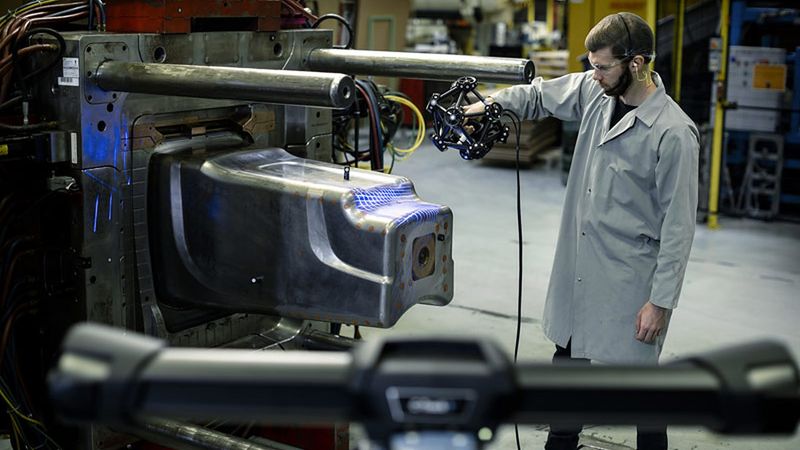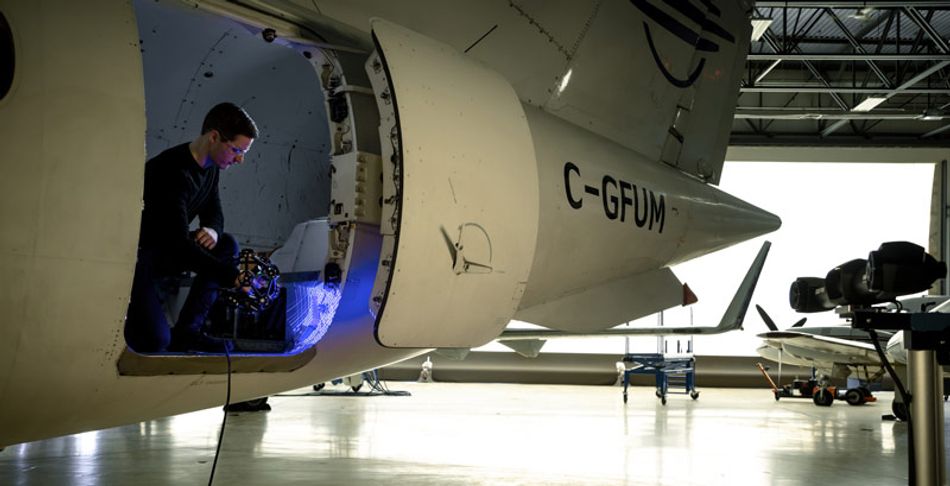The Future Of Industrial Quality Control And Assurance
Whether in the aerospace, transportation, tooling, foundry or casting industries, manufacturers of supplier parts or complete products are increasingly encountering stringent requirements.

How the new MetraSCAN BLACK optical CMM 3D scanner will change the game
Whether in the aerospace, transportation, tooling, foundry or casting industries, manufacturers of supplier parts or complete products are increasingly encountering stringent requirements. These requirements are targeted towards improving the quality of their products as well as reducing their total cost of quality (COQ), which is often attributed to a myriad of factors, including:
- Internal failures
- External failures
- Repetitive appraisals
- Changes to both quality control and quality assurance processes as prevention strategies
Today’s manufacturers, looking to distinguish themselves in their respective markets, are pushing the limits of product design as the freeform design approach to enhance aesthetics and boost functional performance becomes increasingly popular. However, freeform organic shapes present a series of new quality challenges.
Furthermore, product requirements and process improvements to secondary manufacturing operations, such as machining, mean that dimensional tolerances are becoming tighter and tighter; data accuracy, when it comes to inspecting parts for form, fit and function, is more critical than ever before.
On the other hand, production teams are forced to cut costs in any way possible in order to keep price points, COQ, and OPEX costs in check. Quality issues can wreak havoc on a manufacturer’s bottom line due to product recalls, loss in material resources, decreased productivity, and more.
For example, according to the American Society for Quality (ASQ), true quality-related costs can be as high as 40% of total operations. Either companies absorb the costs—or pass the costs down to clients and consumers.
Indeed, quality is a key differentiator for most manufacturers. In the past, quality control and quality assurance were relegated to labs and operated by highly skilled operators. However, design and production methods as well as quality criteria have greatly evolved since traditional CMMs made their way into manufacturing environments.
Unfortunately, the disadvantages of using CMMs have started to greatly outweigh their advantages. New metrology technologies and techniques, such as portable optical CMM 3D scanners, are becoming viable, long-term alternatives. These new 3D measurement solutions are completely changing the game by offering a fast, easy and versatile means to acquire highly accurate 3D measurements—right on production floors.
Let’s take a look in more detail on how portable optical CMMs, like the latest MetraSCAN 3D, surpass conventional CMMs.
How versatile are 3D scanners vs CMMs?
As mentioned before, manufacturers across multiple industries are pushing the limits of prototype concepts and final products. High-precision free-form surfaces may offer great looks and amazing performance levels, yet they present formidable production and inspection challenges.
CMMs are not well-adapted to help inspectors assess difficult surfaces, such as those found with free-form components. The reason? CMMs are suitable for parts that feature “familiar” shapes, like rectangles, squares, circles etc.
Complex shapes require significantly more measurement points with a CMM, which entail lengthy and often cumbersome setups.
The MetraSCAN BLACK, a metrology-grade 3D scanner, allows quality control technicians to acquire highly accurate measurements, regardless of part complexity, material or surface finish.
It features blue laser technology, which, contrary to red lasers, does not generate as much laser speckle. Blue lasers can also obtain smaller spot sizes and a better focus. Both of these advantages contribute to higher scanning resolution as well as a better signal on shiny and metallic surfaces.
Watch how the new MetraSCAN BLACK can effortlessly scan shiny and black parts!
Also, CMMs and other scanning systems have fixed measuring volumes. Contrary to these types of measuring devices, MetraSCAN BLACK allows for greater measurement flexibility for larger parts of up to 10 metres; the optical CMM scanner can easily and dynamically extend the measuring volume without significant loss in accuracy that comes with conventional leapfrog
A final word on versatility. Legacy CMMs are usually set up in a manufacturer’s lab and fixed to the floor. The CMMs use probes that move on three Cartesian axes to conduct dimensional inspections.
The MetraSCAN 3D solution is a portable, arm-free 3D scanning system that uses optical triangulation methods and enables total freedom of movement. Users can easily take 3D measurements of all types of objects located anywhere—even in difficult or remote locations and right on shop floors.
This makes the MetraSCAN BLACK ideal not only for complex and large-sized parts but also for non-repetitive applications, including inspecting prototypes and reverse engineering components with severe quality issues.
Which is faster? A CMM or a 3D scanner?
Whether for first article inspections (FAIs) or performing in-line/at-line quality control, speed is of the essence. New 3D measurement tools for quality control and quality assurance are becoming manufacturers’ go-to solutions. They help to eliminate the unmanageable bottlenecks often associated with CMM dimensional inspections in the lab or dedicated cell.
Beforehand, highly experienced metrologists were dedicated to one CMM. Because of this, different assembly line teams had to wait their turns, literally, for quality inspections to be conducted—part by part. Workflow inefficiencies and costs were often compounded by the fact that setup times for each part could take hours.
From an alternative standpoint, the MetraSCAN 3D optical CMM scanner eliminates the need for warm-up times and allows users to carry out inspections right on the production floor. Furthermore, with its 15 laser crosses, the MetraSCAN BLACK can acquire 1,800,000 measurements per second—even on large surface areas—and generate live meshes; as opposed to other CMMs, it can cut the time between data acquisition and workable files in half.
Finally, quality teams are often tasked to verify supplier or customer part quality before final products can be produced. Again, thanks to the speed in which the MetraSCAN 3D can scan parts, inspectors can quickly verify mission-critical components fabricated by third parties to mitigate production delays and accelerate throughput.
Accuracy that is light years ahead
While CMMs offer good accuracy, they need to operate in controlled environments that are not subject to vibrations, oil, dust or changes in temperature and humidity in order to generate optimal results.
The MetraSCAN 3D does not need to be used in any controlled environment to provide a high level of accuracy; inspectors can use them right on shop floors without measurement precision being affected.
Furthermore, working with CMMs tends to be much more complex, with rigid measurement setups and path programming. This means metrologists are responsible for the entire measurement workflow, from setup to data collection to processing and analyzing results. With accelerated production timelines and the need for speed, metrologists are often bogged down with multiple tasks at any given moment.
The MetraSCAN BLACK, however, offers an unprecedented ease of use for operators of all levels—including technicians without any metrology expertise. Therefore, technicians with just a minimal amount of training and entry-level workers can be assigned to setting up and conducting 3D scans of a part, while metrologists can dedicate their expertise and know-how to making critical assessments.
The MetraSCAN BLACK provides quality control and quality assurance teams the accuracy they need to capture detailed 3D scans. In fact, with unmatched resolutions of 0.025 mm and accuracies of 0.025 mm, the MetraSCAN 3D generates high-precision results, no matter what type of part. It is also impervious to ambient conditions. This high accuracy, based on the VDI/VDE 2634 part 3 standard and because the solution has been tested in a ISO 17025 accredited laboratory, ensures complete reliability and full traceability that are aligned with international standards.

Ergonomic and portable, scanning with the MetraSCAN BLACK is easy as it requires no rigid setups, sophisticated calibration or programming. Any type of user—from beginners to advanced inspection technicians—and acquire accurate, reliable and repeatable measurements with its self-positioning (dynamic referencing) capabilities. In a nutshell, the MetraSCAN 3D takes the guesswork out of dimensional inspections—and affords a level of accuracy that is second-to-none.
The MetraSCAN BLACK is paving the way to a new chapter in manufacturers’ quality control and quality assurance. With its versatility, speed and accuracy, this optical CMM 3D scanner brings robust, reliable and efficient inspections directly in production environments. With the MetraSCAN 3D, unexpected non-compliance, production and part approval delays, and quality costs are significantly reduced.